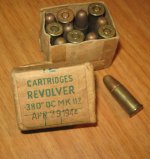Without intending to, over the last year I have accidentally begun to build a type collection of wartime service revolvers from the major 20th-century conflicts. When this wartime Webley became available to me at the appealing price of nothing, I jumped at the chance to add it to the collection. The other WWII examples are a .38/200 Victory and a Colt Commando.
I used to think Webleys were ugly, but I really don't think there is anything ugly about well-realized functional design. There is a kind of crude and reliable can-do aspect to these guns that appeals to me. It sure simplifies interior workings if you put part of the ejection mechanism outside the gun, not to mention that massive latch that goes over the top of the barrel assembly in front of the hammer.


The .38/200 Mk IV was introduced in 1923 and continued in production for 40 years. In 1942 it was designated the official wartime service revolver of Great Britain. I think about half a million were made in all; this one (128508) is from 1944 according to the Webley production tables.
Were the cylinders on these guns all loose? This one seems quite sloppy, showing about 1/8" of rotational play when the action is at rest. The rotational play in the cylinder is much reduced (1/32") when the gun is cocked or in full lock-up after a DA trigger pull. I realize the play is a function of contact with the twin cylinder stops (my terminology, not Webley's), but I wonder if the stops need to be adjusted to make the gun a little less loose.
Yes, I'll shoot it. I foresee getting into the .38/200 reloading game.
I used to think Webleys were ugly, but I really don't think there is anything ugly about well-realized functional design. There is a kind of crude and reliable can-do aspect to these guns that appeals to me. It sure simplifies interior workings if you put part of the ejection mechanism outside the gun, not to mention that massive latch that goes over the top of the barrel assembly in front of the hammer.


The .38/200 Mk IV was introduced in 1923 and continued in production for 40 years. In 1942 it was designated the official wartime service revolver of Great Britain. I think about half a million were made in all; this one (128508) is from 1944 according to the Webley production tables.
Were the cylinders on these guns all loose? This one seems quite sloppy, showing about 1/8" of rotational play when the action is at rest. The rotational play in the cylinder is much reduced (1/32") when the gun is cocked or in full lock-up after a DA trigger pull. I realize the play is a function of contact with the twin cylinder stops (my terminology, not Webley's), but I wonder if the stops need to be adjusted to make the gun a little less loose.
Yes, I'll shoot it. I foresee getting into the .38/200 reloading game.
Last edited:





